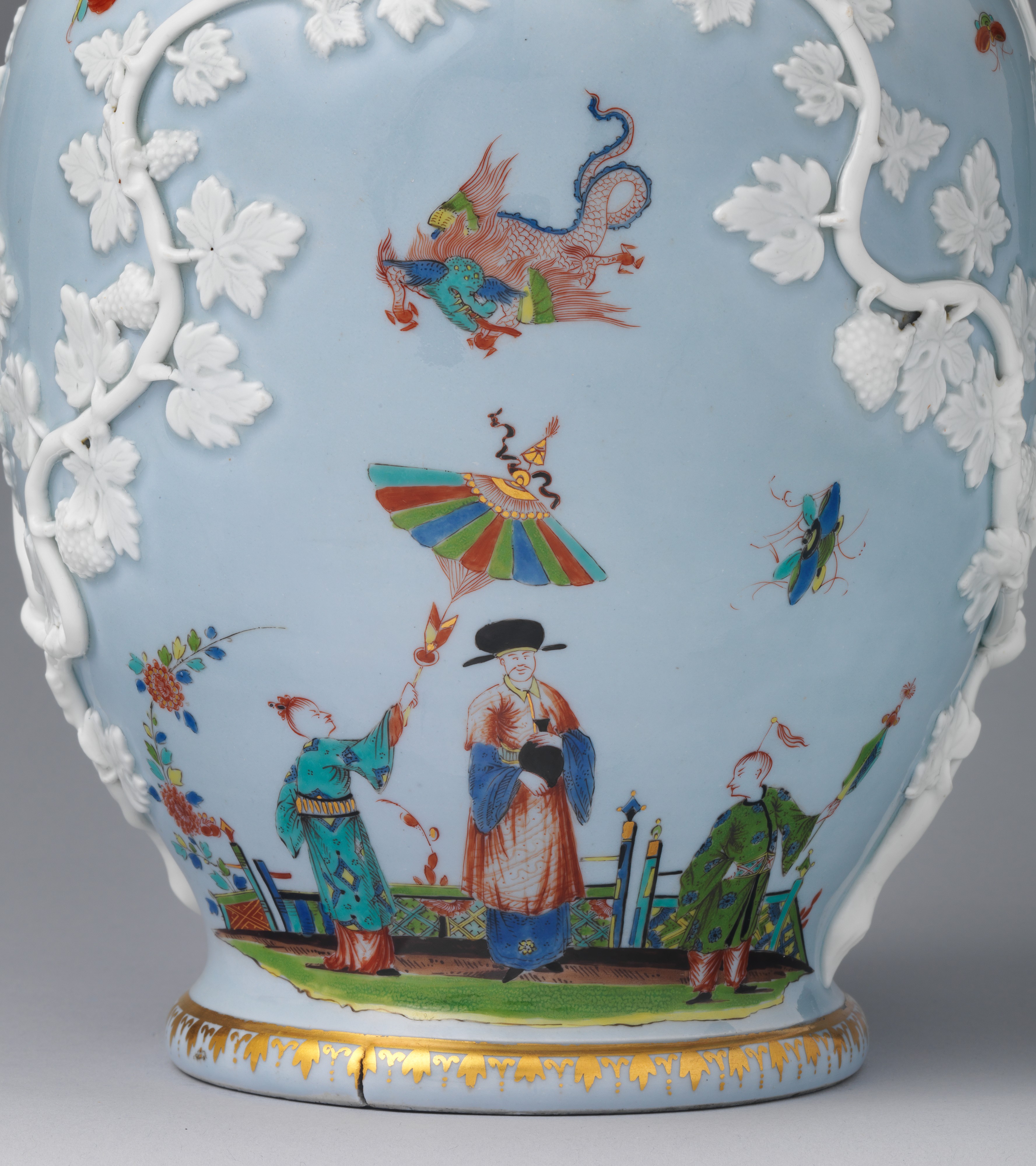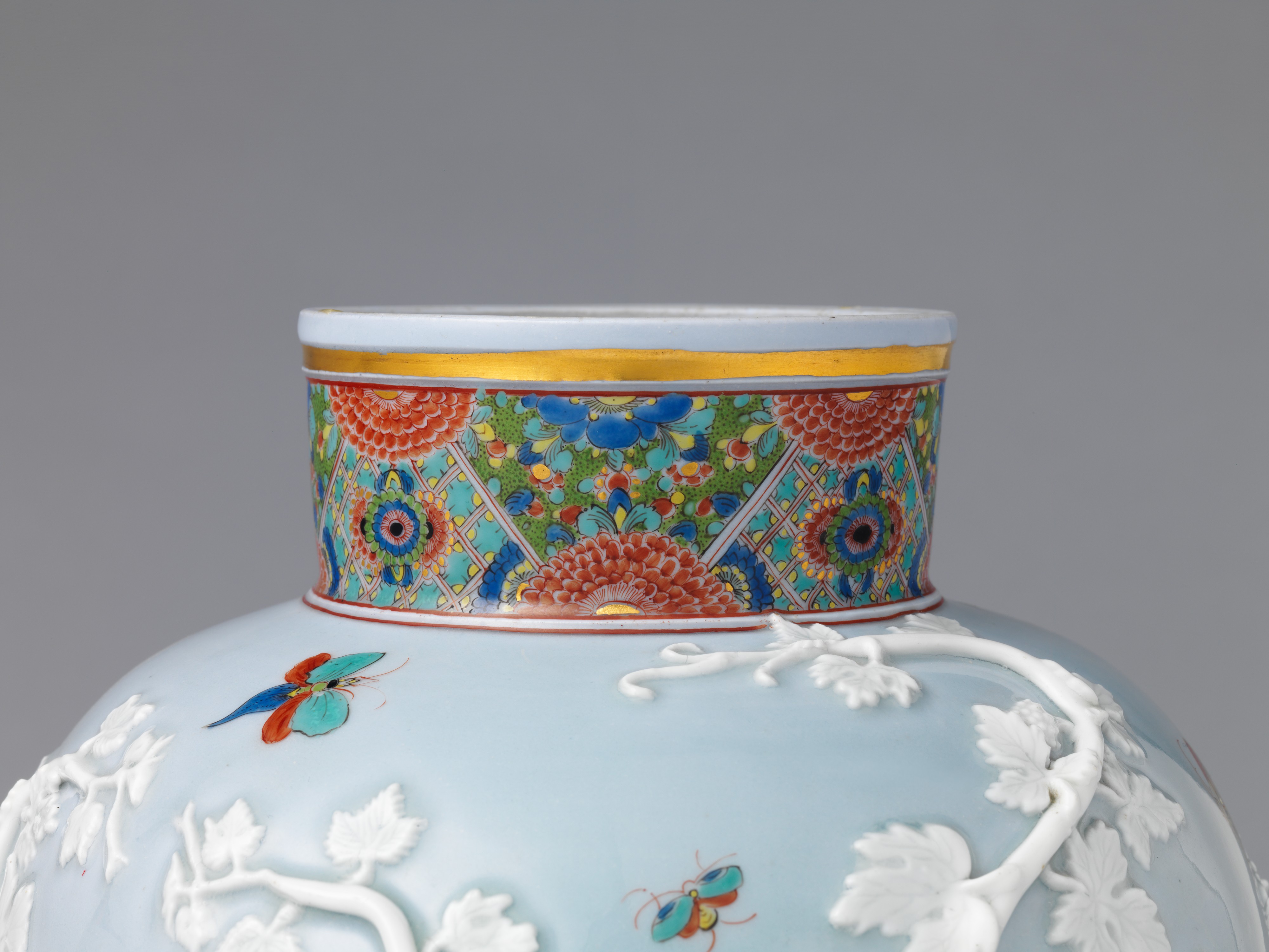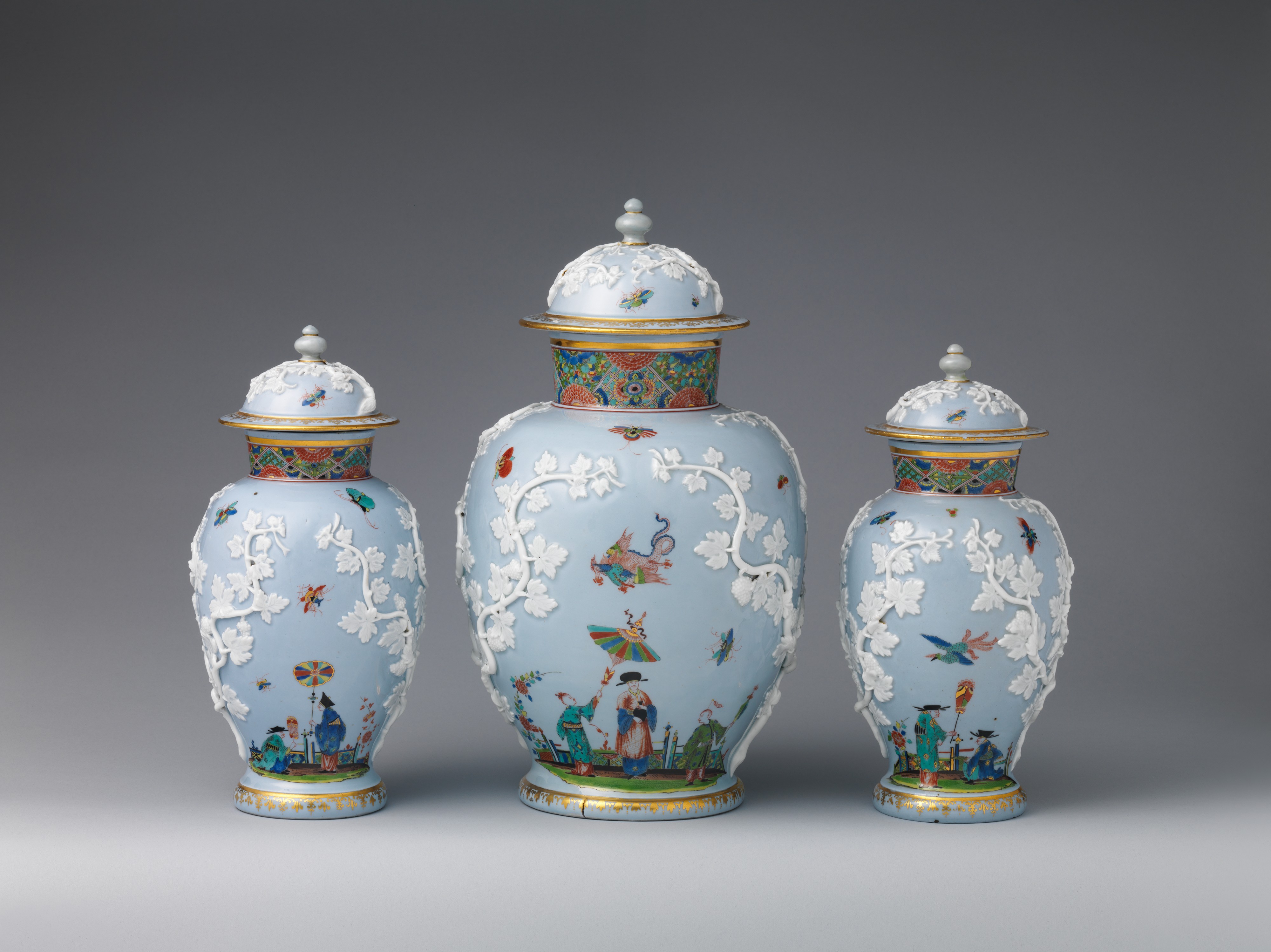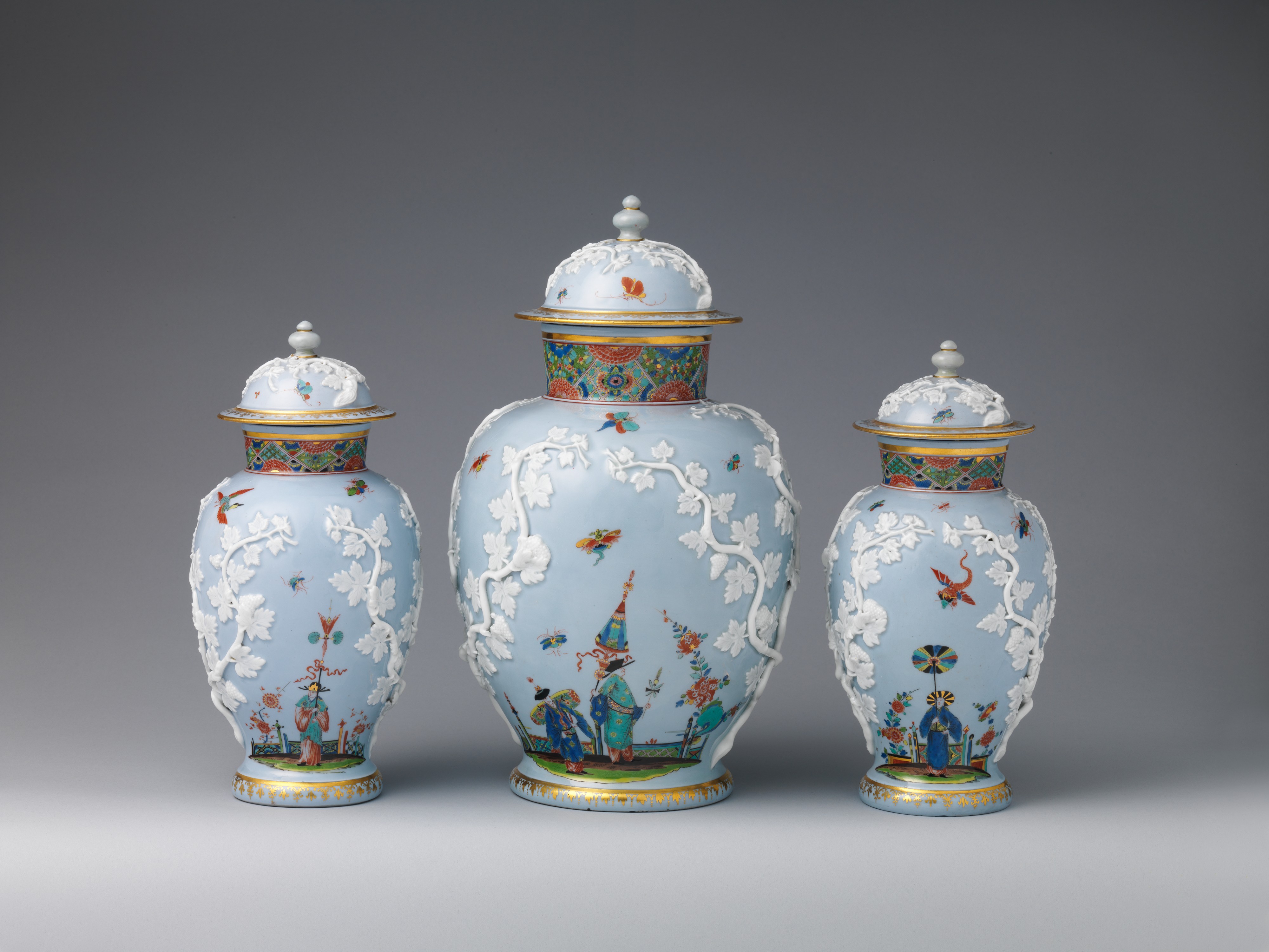Vase (from a garniture of three)
Manufactory Meissen Manufactory German
Not on view
These three vases (64.101.153a, b–.155a, b) are distinctive for their muted blue color, which was achieved by tinting the porcelain paste rather than by applying a blue ground color after the vases had been glazed. The vases were made during the period in which the Meissen factory was experimenting with ground colors, and adding color to the paste before the objects were thrown or molded must have been one of the methods explored. Very few pieces with tinted color were produced at Meissen (see 1977.216.12, .13), suggesting that the results were deemed unsatisfactory. It has been observed by Ulrich Pietsch that enamel colors do not read well against the tinted ground,[1] and it may have been for this reason that adding color to the paste was abandoned after a period of several years in favor of colored grounds applied over the glaze. The standard format that developed for the use of colored grounds left certain defined areas white, known as reserves. Applying the enamel colors within the reserves allowed the brilliant palette developed by Johann Gregorius Horoldt (German, 1696–1775) to be seen to best advantage against the bright-white Meissen paste.
The other known blue-tinted pieces of Meissen include a small cup and a small covered pot in the British Museum, London,[2] a small beaker in the Museum fur Kunsthandwerk, Frankfurt am Main,[3] a tankard in the Porzellansammlung, Staatliche Kunstsammlungen Dresden,[4] and a beaker vase in the Rijksmuseum, Amsterdam.[5] While the decoration of the latter is closely related to the Museum’s vases, the set of three now in New York reflects the most ambitious works produced in this experimental technique. On each of the Museum’s vases, two polychrome chinoiserie scenes are painted just above the foot, with each scene enclosed by low-relief vines with leaves and clusters of grapes. These applied vines, formed of glazed-white porcelain, provide a stark contrast to the blue-tinted body, serving to enhance the blue color and supply a framework for the chinoiserie scenes. The vines were skillfully constructed with molds employed for the leaves and the grape clusters and with modeling by hand for the undulating branches; the crispness of the contours and the veining of the leaves reflect the proficiency of the factory’s modelers. It must have been perceived at the factory that the use of white porcelain in low relief on the blue-tinted body created a pleasing visual impact, because all of the pieces cited above employ this contrast.
The use of applied ornament, especially in the form of vines, leaves, or flowers, is commonly found on the porcelain made in the earliest years at the factory by Johann Friedrich Bottger (German, 1682–1719), approximately between 1713 and 1720.[6] As the factory did not have the necessary technology to fire enamel colors successfully at this time, low-relief ornament provided the most effective form of decoration (see 42.205.26). The presence of the applied vines on these vases is a continuation of that decorative technique, and the grapevine motifs seen here were used as early as 1715, when they decorated a teapot now in the Cummer Museum of Art, Jacksonville, Florida.[7] However, the visual effect of this applied ornament is completely different on the Museum’s vases not only due to the blue-tinted ground but also because the vines are used in combination with enamel decoration.
On each vase, there are two primary branches, and each branch divides into three smaller branches. Of these smaller branches, the two outer branches curve outward before reversing the curve to come near to joining where they terminate, forming a type of arch above the painted scene. The compositions of the chinoiserie scenes are defined by this framework, and it is possible to read the scrolling vines as an extension of the fantasy landscapes depicted in the enamel colors. The applied vines are further integrated into the overall compositional scheme by the presence of the small insects painted as if they were flying around the branches, and in some cases seeming poised to alight on one.
The six chinoiserie scenes on the three vases reflect all of the characteristics that made this type of decoration popular at Meissen in the 1720s. The figures are dressed in elaborate costumes intended to make them instantly recognizable as Chinese, with distinctive hats, in particular, that mark the figures as “exotic.” The robes worn by the figures are decorated with detailed patterns painted in a palette of vibrant colors, and the abbreviated landscapes in which the figures stand are defined by bands of ornamental fencing that echo the patterning of the costumes. A vertical element is added to each scene in the form of a parasol, an ornamental fan, or a pole with decorative streamers, and these compositional devices help define the areas bordered by the applied vines. It is not possible to attribute the decoration on these vases to a specific painter, but this type of painting is often described as being in the manner of Johann Ehrenfried Stadler (German, 1701–1741),[8] who was employed by the factory around 1723.[9]
All of the blue-tinted works produced at Meissen are ascribed to the years 1725–30, and it was during this period that the factory developed the technical expertise to apply ground colors successfully. By the late 1720s Meissen was able to employ a range of grounds that included yellow, blue, a pale turquoise, and purple,[10] and as a result, the interest ceased in coloring the porcelain paste itself.
Footnotes
(For key to shortened references see bibliography in Munger, European Porcelain in the Metropolitan Museum of Art. NY: The Metropolitan Museum of Art, 2018)
1 Ulrich Pietsch in Pietsch and Banz 2010, p. 273.
2 British Museum, London (Franks 72). The cup is illustrated in Dawson 1985, pp. 12–13, no. 7. 3 Bauer 1983, p. 36, no. 9.
4 I. Menzhausen 1990, p. 202, pl. 84.
5 Blaauwen 2000, pp. 74–75, no. 37.
6 Similar applied floral ornament is occasionally found earlier on Meissen red stoneware as well; see Johann Friedrich Böttger 1982, no. 1/41.
7 Pietsch 2011, p. 82, no. 29.
8 Cassidy-Geiger 2008, p. 392.
9 Pietsch 2011, p. 317.
10 See, for example, Blaauwen 2000, pp. 66–70, no. 34, pp. 82–83, no. 42, pp. 88–89, no. 45, p. 92, no. 47, p. 110, no. 57.
Due to rights restrictions, this image cannot be enlarged, viewed at full screen, or downloaded.
This artwork is meant to be viewed from right to left. Scroll left to view more.






